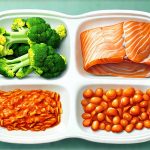Digestion is often viewed as a passive process – food simply enters our mouths and somehow transforms into usable energy. However, it’s an incredibly dynamic and complex system, profoundly influenced by factors far beyond just what we eat. Two particularly significant, yet frequently overlooked, elements are the temperature of our food and the speed at which we consume our meals. These seemingly minor details dramatically impact how efficiently our bodies break down food, absorb nutrients, and ultimately, how well we feel. Understanding these influences empowers us to make conscious choices that support optimal digestive health and overall wellbeing.
The digestive system is a marvel of biological engineering, designed to extract essential components from the foods we consume while discarding waste. It’s not a monolithic entity but rather a coordinated network involving organs like the mouth, esophagus, stomach, small intestine, large intestine, pancreas, liver, and gallbladder – all working in precise synchronicity. This process isn’t solely chemical; it also relies heavily on mechanical actions (like chewing and peristalsis) and neural signaling. Therefore, anything that alters these fundamental aspects of digestion—temperature, pacing, even stress levels—can disrupt the entire system’s delicate balance, potentially leading to discomfort, reduced nutrient absorption, or other digestive issues.
Food Temperature & Digestive Efficiency
The temperature of our food significantly impacts several stages of digestion, starting even before it reaches the stomach. Consuming foods that are too hot can scald the mouth and esophagus, causing inflammation and hindering initial breakdown processes. Conversely, very cold foods require the body to expend energy warming them up to body temperature within the digestive tract, potentially slowing down enzymatic activity. Optimal food temperatures generally align with lukewarm or room temperature, allowing for easier processing without excessive energy expenditure.
This isn’t just about comfort; it’s about enzyme function. Digestive enzymes operate most effectively within a specific temperature range – close to our core body temperature (around 98.6°F or 37°C). Extreme temperatures can denature these enzymes, rendering them less effective at breaking down food molecules. For example, amylase in saliva begins carbohydrate digestion in the mouth, and its efficiency is compromised by extremely cold temperatures. Similarly, stomach acid production and pepsin activity (for protein breakdown) can be affected by foods that are drastically different from body temperature.
Furthermore, certain cultures have long traditions around food temperature for digestive reasons. Ayurveda, the ancient Indian system of medicine, emphasizes warm, cooked foods for optimal digestion, believing they are easier to process than cold or raw options, particularly during colder seasons. While not universally applicable, these practices highlight a recognition that food temperature plays a role in how our bodies handle different types of nourishment. Understanding the connection between hormonal changes and digestion can also be valuable.
Meal Pacing & Digestive Signaling
Beyond temperature, how quickly we eat significantly impacts digestive response. Rapid eating overwhelms the digestive system, hindering its ability to effectively process and absorb nutrients. When we wolf down our meals, we don’t give our bodies adequate time to signal satiety – that feeling of fullness – leading to overeating. This is because it takes approximately 20 minutes for hormonal signals from the gut to reach the brain, informing it that we’ve had enough food. Eating quickly bypasses these crucial signaling pathways.
More importantly, meal pacing affects gastric emptying – the rate at which food leaves the stomach and enters the small intestine. A slower, more deliberate pace allows the stomach to properly mix food with digestive juices, breaking it down into a chyme (a semi-fluid mass) that’s easier for the small intestine to absorb. Rapid eating results in larger boluses of undigested food entering the small intestine, potentially causing bloating, gas, and malabsorption. Slowing down allows for more complete digestion and nutrient extraction. This is an important aspect of rebuilding safe food patterns.
The gut-brain axis plays a vital role here. The digestive system communicates constantly with the brain via the vagus nerve. Faster eating can disrupt this communication, impacting not only digestion but also mood and overall wellbeing. By consciously slowing down our meals, we allow these crucial signaling pathways to function optimally. It’s important to recognize how anxiety can impact this process too.
Strategies for Optimizing Meal Pacing
Implementing strategies to slow down meal pacing isn’t about restrictive dieting; it’s about mindful eating practices that support digestive health. Here are a few actionable steps:
- Chew thoroughly: This is perhaps the most important step. Aim to chew each bite 20-30 times before swallowing, breaking down food mechanically and initiating enzymatic digestion in the mouth.
- Put your fork down between bites: Consciously pausing allows you to savor your food and assess your satiety levels.
- Eliminate distractions: Turn off the TV, put away your phone, and focus solely on your meal. Distractions lead to mindless eating and faster consumption.
- Practice mindful breathing: Taking a few deep breaths before each bite can help you slow down and become more aware of your body’s signals.
The Role of Fiber & Hydration in Temperature & Pacing
The effects of food temperature and meal pacing are intertwined with other dietary factors, particularly fiber intake and hydration levels. Fiber adds bulk to the digestive process, slowing down gastric emptying and promoting a sense of fullness – which naturally encourages slower eating. However, sufficient water is crucial for fiber to function effectively; otherwise, it can lead to constipation.
Furthermore, warm liquids (like herbal tea) can aid digestion by relaxing the digestive muscles and improving blood flow to the gut. This is especially helpful when consuming fibrous foods. Conversely, very cold beverages can constrict these muscles, potentially hindering digestion. Combining mindful pacing with adequate hydration and fiber intake creates a synergistic effect, maximizing nutrient absorption and minimizing digestive discomfort. Proper posture also contributes to optimal digestion.
Individual Variability & Digestive Sensitivities
It’s important to recognize that everyone’s digestive system is unique. What works for one person may not work for another. Factors like age, genetics, existing health conditions (such as Irritable Bowel Syndrome or GERD), and individual sensitivities all play a role in determining optimal food temperature and pacing strategies.
- Some individuals might be more sensitive to cold foods, experiencing bloating or discomfort with even mildly chilled options.
- Others may have faster metabolisms and tolerate quicker meal times without issue.
- People with conditions like gastroparesis (delayed stomach emptying) may benefit from smaller, more frequent meals eaten at a slower pace.
Paying attention to your body’s signals is paramount. Experimenting with different temperatures and pacing strategies can help you identify what works best for your digestive system. If you experience persistent digestive issues, consulting a healthcare professional or registered dietitian is always recommended to rule out underlying medical conditions and develop a personalized plan. Consider the impact of acid exposure as well. Lastly, remember to consider how your environment’s temperature impacts digestion.


















